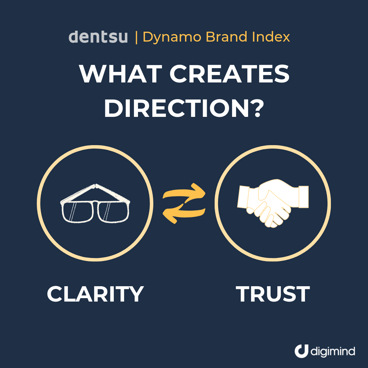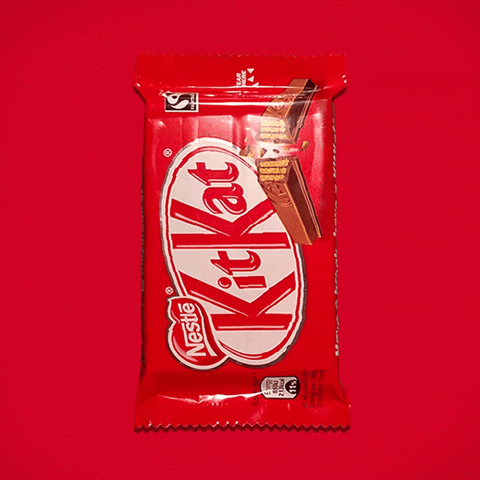Creating Direction and Trust with Social Media Listening | Dentsu Dynamo Brand Index
Have you ever wondered why brands like KitKat and Microsoft are so successful at building and maintaining their brands, while others struggle to stand out and survive? What are the key traits of a recognizable brand with a clear value proposition in the New Economy?
Dentsu’s 2019 Global Dynamo Brand Index, created in partnership with Digimind, combined insights from over 22,000 consumers surveyed, as well as Digimind’s rich social data set, to not only understand where the world’s top brands currently stand, but also identify where they are moving to.
In our previous post about Dynamo Brands, we highlighted high Energy brands that are able to constantly innovate and offer new value to their customers. Today, we explore the second element of a Dynamo Brand that turns Energy into impact – Direction.
What is Direction and Why is It Important For Brands?
Direction is defined by Dentsu’s Dynamo Brand Index as a brand’s clarity and relevance.
In this New Economy, it is vital for brands to have a strong sense of direction and consumer trust. With new brands and technologies constantly emerging, once dominant players are not only faced with new competitors but also digital disruption. Four out of five largest companies in the world today were not even listed in the top 30 brand rankings a decade ago. Clarity and relevance, as well as a strong sense of where a brand is heading, are thus crucial for ensuring longevity against the tides of change.
What Creates Direction?
According to Dentsu’s Dynamo Brand Index, Direction is created with clarity and trust.

Clarity refers to how clear a brand is about its offerings in the minds of consumers.This grants them the fluidity to move people and businesses amid changes in the economy.
Trust is what businesses need to build for the entire company, not just products offered. To be successful, a brand needs to be trusted by consumers to try new things.
How KitKat and Microsoft Create Direction
Kitkat is famous for its continuous invention of exotic flavored chocolates. Since 1957, KitKat has been known by its famous tagline, “Have a break, have a KitKat”. This clear focus to provide customers with a break from their daily lives, has built decades of trust between brand and consumer. The benefits of this clear brand position is clear: 25 million Facebook followers in Japan alone, constantly sharing their latest discoveries from KitKat.

Two decades ago, Microsoft ruled the world of computing, thanks to the popularity of the Windows operating system. However, its model was soon disrupted by Apple and Google.
In order to bounce back from this period of extreme disruption, Microsoft’s new CEO, Satya Nadella then set out to double down on its strengths. To build trust with consumers, Microsoft undertook the following steps:
- Employed an open and transparent culture, a contrast to their competitors whose operations were kept in secrecy
- Embraced open-source platforms like GitHub
- Designed products that were compatible with competing brands
Through these measures, Microsoft achieved the following:
- Re-established consumer trust in the company
- Reclaimed its status as the world’s most valuable brand
How to Create Direction with Social Media Monitoring
Before you can get consumers to trust you, you first have to know what they want. A social media listening platform like Digimind Social can help you understand each group’s needs, wants, and pain points based on key conversation trends in real time. In turn, you can then build relationships and trust by offering relevant contents and products.
Bonus: Discover how AXA creates brand loyalty and trust by leveraging social listening insights.
Define and drive your brand’s Direction with social media listening through the following steps:
- Optimize brand offerings and communications
- Evaluate and optimize your brand's purchase journey
- Measure your campaign's performance
Optimize brand offerings and communications based on moments and habits of consumption: When posting on social media, internauts often share the time and context of their consumption, especially for F&B brands. Capture insights on such moments to:
- Identify associated products to adapt content and offers
- Focus communications around leading topics from consumer discussions and user generated content
- Integrate targeting strategies, or even adapt offers and packaging to consumption trends and contexts
Evaluate your brand’s purchase journey and optimize your customer experience: Consumer insights can help you understand the different stages of your customer’s journey. Use a social media listening tool to capture these insights and organize them by the key stages of the customer’s journey, specific to your industry.
Track your brand’s clarity by measuring your campaign’s performance: A campaign or brand with a strong Direction, is one that effectively drives positive consumer conversations and sentiments. To measure the success of your brand’s campaigns and communications, track the volume and sentiment of your earned media in real time. It is imperative to establish all necessary elements, including messaging, KPIs, and data collection prior to the launch of your campaign.


